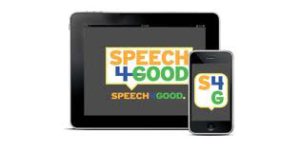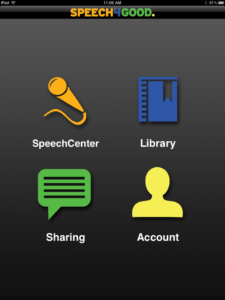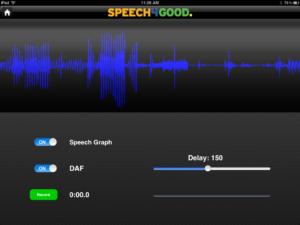Update 11/7/2012: Shane won the free copy of this app. Congratulations!
I remember using Delayed Auditory Feedback (DAF) therapy with fluency clients in our university clinic (Wahoowa! UVA!) and, while it seemed to offer benefits in the session, it seemed tremendously impractical. I had a few adult clients that needed to “see” that their speech could become more fluent, but the process was so slow going due to the infrequency of session. I also remember thinking, how on earth would I ever afford the thing? Could I justify the expense if I wasn’t primarily working with this diagnosis?
Not an issue these days! The Speech4Good iPad/iPhone/iPod touch app by Balbus Speech, has made DAF extraordinarily accessible. It’s portable, it’s inexpensive and, since it uses “regular” devices, it’s cool looking! (Available in the iTunes store, $19.99)
The app is very simple to use. The home screen gives you four choices: Speech Center, Library, Sharing and Account. Click on the Speech Center and you will be looking at an oscilloscope. Choose your settings: speech graph (on/off), DAF (on/off) and what delay (20-300), and record (on/off). If you are using DAF you will need to plug in headphones/buds. Then start talking! The graph is great visual feedback for your speaker. A fluency client can actually see the moment of disfluency, which is great for those clients who sometimes have difficulty identifying where they had trouble. They can also see what easy onset looks like or “stretchy” speech.
Once you’ve done some recordings you have options to save and share. This particular feature is awesome because it can be used for home practice accountability. Since the app is reasonably priced, I would recommend a family download a copy for home practice, set some goals (i.e. 10 min/day) and have them email me the recordings as they go. It also gives you space for a message, so the client could give some immediate feedback on how they thought the session went. Just the idea that a student could now use DAF on a regular basis, enough so that they would begin to see changes outside of DAF…There’s some more fluency magic for you!
The app doesn’t have to be used strictly for fluency. Voice and articulation clients can reap the benefits of visual feedback as well. Simply turn off the DAF feature and start watching and recording! A lite version is also available. (iTunes store, $4.99)
Speech4Good provided me with a copy of their app, but all opinions are mine. They have also generously provided an additional copy for a lucky reader! To enter let me know what university clinic you worked at and what kind of fluency therapy you did. Contest ends Tuesday, November 6, 2012 at midnight EST. The winner will be chosen at random and notified on November 7, 2012. Good luck!









This Post Has 17 Comments
During my undergraduate and graduate studies at the University of Alabma (Roll Tide!) I had the opportunity to work in many settings for my clinical practicums–from on campus speech and hearing clinic to hospitals to public schools. I honestly can’t recall my experience with fluency clients. I know it wasn’t much. I like the idea of this app, being that it provides visual feedback…and it’s affordable!
I did my undergraduate work with Harold Starbuck at State Univ. of NY at Geneseo. It was good old stuttering modification therapy (they still offer a DVD at the Stuttering Foundation of Hal in the 70s working with a group of stutterers.) As a professor (and stutterer himself) he employed all his techniques when lecturing –post-block corrections, in-block corrections, pre-block corrections, and pre-determined speech. I didn’t learn about DAF until I was already working and went to a seminar. There is still a great clinic at Geneseo named in Hal’s honor – Harold B. Starbuck Memorial Fluency Enhancing Clinics, Geneseo, N.Y
While working on my Master’s degree in Speech Language Pathology at the University of South Carolina (Go Gamecocks!), I worked in our university Speech and Hearing clinic with an adult male stutterer in his 20’s using a computerized program with Delayed Auditory Feedback. I remember it so well because I was amazed at how much progress he made using this DAF program compared to less progress with a traditional fluency program. I remember trying it myself and being so distracted by listening to the DAF that it was harder for me to keep talking! I am so glad that this app was developed to help those who benefit and have the need for it. I’m sure it will be well worth the cost, but on a public school clinician’s salary, I would love to win this app for FREE! THANKS SO MUCH!
I completed my Master’s degree in Speech/Language Pathology at Lamar University in Beaumont, TX. We used a variety of traditional therapy approaches and techniques (fluency modification/fluency shaping) to treat fluency patients in the speech and hearing clinic there. I have several prescshool stutterers on my caseload; I would love to win this app and try it with these little ones!
Remembering those days at Ohio State – still have some worksheets from Dr. Florence for use with DAF program. The visual component looks very interesting especially for establishing awareness for those students who tell me that they don’t stutter. Thank you for the chance at a FREEBIE.
I graduated from Purdue University-Boiler up!. For many years, we only used the VanRiper method for fluency remediation. I remember using DAF and was amazed at the changes in stuttering behaviors. In my current practice there is no DAF technology. I would love to win the Speech4Good app so that each of my current 4 stutterers could experience the “joy” of fluency.
I did my graduate work at the University of Utah. We did an intensive therapy program using a modified version if the Successful Stuttering Management Program.
I graduated from Harding University then did my graduate degree at Abilene Christian Univerity back in the 80’s. We practiced traditional approaches to fluency therapy including easy onset, light contacts, and connected speech. Last year I started using a program called Speak Freely which I really like. I’ve never used DAF but I’m very interested in trying it with a student in one of my self contained classes who stutters severely. He even seems to block on his breathing. He joined in with signing with other students and initially that seemed to ncrease fluency, but as time went on he started doing repetitive stuttering type movements with his signing! Now we are working on relaxed breathing and easy stretched phonation. Sorry, I didn’t mean to write a book…there’s just so much to say about this great kid whose stuttering is sometimes crippling. I am interested to see if DAF would benefit him. Thanks for the suggestion!
I did my undergrad and grad studies at east Carolina university. I studied under Dr. Shine, Dr Rastatter, Dr Kalinowski, and Dr. Stuart in the area of fluency with focus on DAF and easy onset speech. I actually helped them with some of their research and helped to write a published journal article on the effects of altered auditory feedback on fluent and non fluent speakers. I always found fluency to be exciting and intriguing.
I graduated from Central Michigan University. We used traditional therapy techniques in our speech clinic.
I graduated from James Madison University with my undergraduate degree and Northwestern University for my masters. At NU, I studies under Dr. Gregory. It was an amazing experience. I most vividly remember the adult clinic–an intensive program that helped teach techniques through a hierarchy of activities until we worked in the community. The techniques were traditional approaches to fluency therapy including relaxation techniques, easy onset, light contacts, intentional stuttering, as well as counseling. I’ve never used DAF but I’m very interested in trying it . There are several students in the school this year that are having significant issues with fluency– blocks and some secondary behaviors. Thanks for the suggestions and information!
I did both my undergratuate and graduate work at University of Florida (Go Gators!). We did not have any fluency clients in our clinic while I was there, but I have had several over the years. In fact, I am working with a teenager now with extremely dysfluent speech and I would love to try DAF with him. I was so happy to read about this in your post – thank for this and all the others!
Jill, it’s been quite awhile since I’ve worked with any teens and I would imagine fluency issues at that age would be a real challenge. It would be a fabulous use for this app. Good luck! Kim
I went to Tx Woman’s University and I had a class in fluency but never worked with a child who stuttered until first year out and he taught me as much as I taught him. Since then I’ve strived to learn as much as I can bc I this population is fu albeit difficult. I just evaluated a 17 year old senior who thinks he will never become either a chef nor a graphic designer “because of his speech” and doesn’t think he will get married “because of his speech”. I would love to try this with him! Thanks for such an awesome blog.
Montclair State University Center for Audiology & Speech-Language Pathology.
Used Smooth Speech and Cognitive Behavioral Therapy with an adolescent PWS.
Tyndale Theological Seminary and Biblical Institute- Biblical Studies
I did not work in the university clinic while working on my master’s degree at Florida State University but I did when I was an undergrad at the University of Central Florida. I didn’t have any fluency clients at the time but it has always been very close to my heart as I have a sibling who is dysfluent. I have many clients for whom insurance does not cover for this condition and it is nice to see an app that can be a very useful technology in their treatment since money and time are of the essence!
Comments are closed.